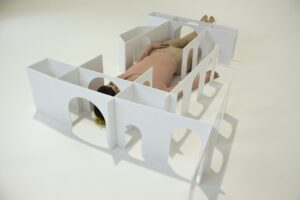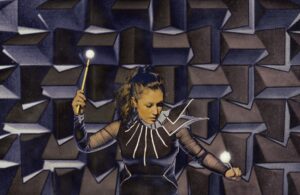Energy House exhibition as science and art collide
26th February 2025, 10:53 am
This Spring Castlefield Gallery will launch an ambitious exhibition of new work by artists Mishka Henner and Emily Speed, in partnership with the University of Salford Art Collection and Energy House Labs.


The exhibition will be the culmination of 18-month Artist Residencies with Energy House 2.0 at the University of Salford, a period in which the artists have immersed themselves in this world-leading energy performance facility, its cutting-edge research, and the facilities and research of the wider university.
A unique facility, Energy House delivers pioneering research on how carbon neutral and net zero homes, the homes of the future, will be built. Energy House 2.0’s chamber can accommodate two full-sized detached houses and simulate climatic conditions including wind, rain, snow, solar radiation and extreme temperatures. Research at Energy House cuts across science and technology, architecture, design and our rapidly changing climate; the artists’ residencies have taken Henner and Speed on different yet intersecting journeys.
At Castlefield Gallery, Henner will present a sound and video installation, which responds to data from the Blitzortung network of over 10,000 lightning sensors positioned across six continents. Each time a lightning strike occurs somewhere in the world it will be recorded on a graphic musical score developed by Henner, which in turn triggers the sounds of percussion instruments. The work will create unique sonic events in the gallery which connect listeners’ bodies to live data recorded on a planetary scale.
This piece by Henner is comparable to the day-to-day activity at Energy House 2.0 where scientists and researchers collect data from countless sensors and devices located in and around the houses built inside the facility’s chambers. That data provides information about the houses, the materials they are made from and how they react to various atmospheric conditions.
During his residency, Henner felt the spectre of the climate catastrophe haunted the facility. His work in some sense turns the kind of activity carried out at Energy House 2.0 inside out, putting visitors at the centre of a system which receives data triggered by climatic events from across the globe.
Speed considers the houses in Energy House 2.0 as 1:1 models, and in addition to testing materials and energy use, has engaged with the facility’s spaces as sites ripe for challenging ideas and exploring new possibilities. Speed’s work seeks to question how the minimal space requirements and heteronormative family-based design of many new-build houses affect the way we interact and cohabit.
Kitchens are of particular interest to Speed, an often-overlooked site of daily ritual, existing at the cross-section of gendered household roles and hyper-capitalist consumerism. Idealised kitchens feature in countless social media posts, coffee table books, and glossy fashion and lifestyle magazines that encourage the types of consumption that may undermine work done by ventures such as Energy House 2.0 to build and maintain homes more sustainably.
During the Energy House 2.0 residency, Speed used floor plans as a way of exploring how we live and how we might need to live in the future. For the exhibition Speed has been developing fabric floor plan sculptures, scaled to real houses, which will hang in the gallery’s double-height space like a rail of clothes, creating a direct relationship between the human scale of the viewer and the footprints of these different homes.
Scale plays an important role in both artists’ work, perhaps to confront us with the complex intertwining of ideology and architecture, or equally the incomprehensible forces of nature. Their works will certainly demonstrate the entanglement of the technological, domestic and planetary spaces that are important to their work and that of Energy House 2.0.
Both artists have reflected on the importance yet scarcity of artist residencies of the kind they have been engaged in at the University of Salford, especially on the time, freedom and research possibilities the period has afforded them. Additionally, Henner has highlighted how important being able to ‘use the entire university as his studio’ has been to his process.
Throughout their residencies, Henner and Speed have worked closely with Professor Richard Fitton and the team of scientists and researchers at Energy House 2.0. The artists have also drawn from the expertise and experience of various facilities and individuals from across the University of Salford including the Acoustics Department, School of Arts, Media and Creative Technology, Maker Space, and PhD students, as well as Castlefield Gallery, the University of Salford Art Collection and Open Eye Gallery.
‘Our most recent artists in residence Mishka and Emily, in my eyes are completely different in their approach to the subject, Mishka with his thirst for data and inputs, generating imagery from our sometimes quite dull data, whereas Emily is examining our test homes, and considering how people might have seen these homes through the ages, and comparing and contrasting the “home of the future” with the homes of the past. I look forward to seeing their final works as I am sure they will see and represent our work in a way that is not only outstanding but fascinating for the public’. PROFESSOR RICHARD FITTON (PhD) FRICS.
Exhibition Title: Energy House 2.0: Mishka Henner and Emily Speed
Exhibition dates: Sunday 4 May – Sunday 20 July 2025
Preview: Thursday 1 May 2025
Slow Saturday Preview: Saturday 3 May 2025
Images available HERE
More on Energy House 2.0 Artist Residencies on the Talking Salford Podcast HERE
Venue: Castlefield Gallery, 2 Hewitt Street, Manchester M15 4GB
Tel: 0161 832 8034
Web: castlefieldgallery.co.uk
Email: [email protected]
Opening Times: Wed to Sun 12noon – 5:30 pm
Presented in partnership with the University of Salford Art Collection and Energy House Labs
Exhibition public programme
Further events and information are to be announced.
For further information and images, or to arrange interviews, please contact: Leslie Remonato at Castlefield Gallery at [email protected] or 0161 832 8034
Next Article
Discover the impact of degree apprenticeships at Manchester Met